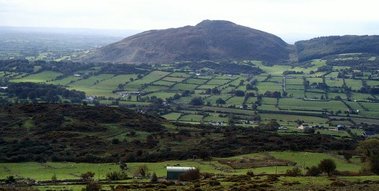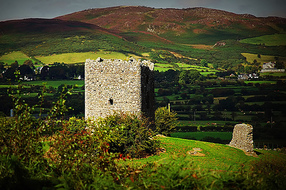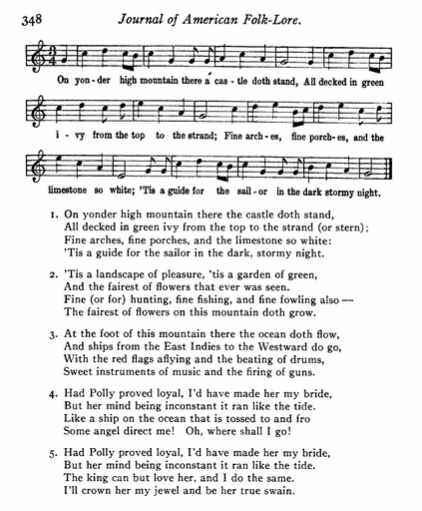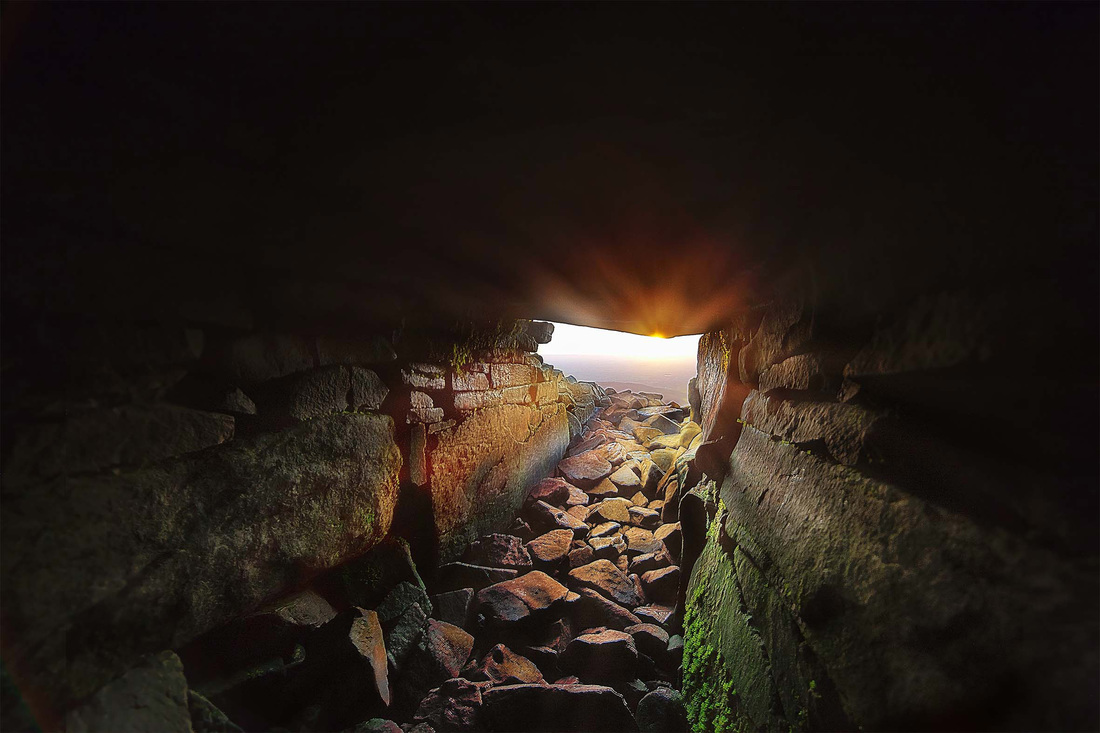BlogStories, Research & Projects
|
|
The Newry Mountains lie about 2 miles west of the town of Newry in Northern Ireland. They consist of Slieve Gullion (1,880 feet), Camlough Mountain (1,385 feet), and Ballymacdermot Mountain (1,019 feet). Slieve Gullion takes its name from the Gaelic Sliabh gCuillinn meaning "mountain of the steep slope”. It is one of the finest detached mountains in the kingdom, separated from Camlough Mountain by a deep valley, and rises abruptly from the plain known as the Ring of Gullion, an Area of Outstanding Natural Beauty (AONB). Near the top of Slieve Gullion is a small, deep lake, and on the very summit of Slieve Gullion are two ancient burial carns. One of these was an artificial cave formed of dry masonry. It is thought to be the highest surviving passage grave in Ireland (pictured below). According to local legend, an enchantress dwelt in this cave, the fairy daughter of Culand, the mythical smith of the De Dannan. Camlough Mountain is also known locally as Newry Mountain, or “Slieve Girkin”, which possibly derives from Sliabh gCuircín: 'Mountain of the little crest’. I have found a song known by many titles over the years, but the most recent version I have come across is called "On the Top of Newry Mountain". "On the Top of Newry Mountain" LYRICS Oh, I wrote to you, Nellie, what makes you prove kind? What makes you pull that lily, leave that red rose behind? For the lily it will fade and the time will come soon but the red rose will flourish in the sweet month of June. Slieve Gullion is a mountain, its stands in great fame at the top of Newry Mountain it bears a great name For a-hunting and a-grousing and a-fowling also and the best of bilberries on that mountain does grow. On the top of Newry Mountain, a castle does stand It is bound round with ivy from the top to the brim It is bound round with ivy and a marble stone bright, It’s a pilot for sailors on a dark stormy night Not far from Newry Mountain, sure, a river does flow and the ships that sail upon it into Newry will go Where the green flags are waving to the beating of drums and instruments play music ‘midst the firing of guns. Sure, if I was in Newry, I would sigh I was home for there I have a sweetheart but sure here I have none Kind sweetheart, kind sweetheart, what makes you prove kind that you wait on a young man, not knowing his mind. History of the SongThis song has a fascinating life-span. According to one online source, a version of was first collected in 1893 as English folksong “Faithful Emma” (Broadwood/Maitland). It is believed to share one verse with another English song, "The Streams of Lovely Nancy": At the top of this mountain a castle does stand / It is decked round with ivy and back to the strand / It is decked round with ivy and marble stone white / It's a pilot for sailors on a dark stormy night. Below are the lyrics of “Faithful Emma”, which are very similar. According to Broadwood/Maitland writing in 1893, this text is either the beginning and end of one ballad, or the first three verses of one tacked on to the ending of another. At the top of yonder mountain, where my true love’s castle stands It’s all overgrown with ivy from the top down to the strands Fine arches, fine porches and diamond stones so bright It’s a pilot for the sailors on a dark and stormy night At the bottom of this mountain, there’s a river runs so clear And a ship from the West indies she did once anchor there With her red flag a-flying and the beating of her drum Sweet instruments of music and the firing of her gun If little Mary had proved faithful, well, she might have been my bride. But her mind it was more fickle than the rain upon the tide Like a ship upon the ocean that is bobbing to and fro And the angels might direct her wheresoever she may go. In 1917, the same song is published as “On Yonder High Mountain” in ‘Ballads and Songs’ (ed. G L Kittredge) in The Journal of American Folklore, Vol. XXX, No. 117, pp. 347-348 (Jul-Sep 1917 - available online by JSTOR). Kittredge's version was communicated in 1914 by Professor Angelo Hall of Annapolis, Maryland. He had learned the sung from his aunt, Mrs Elmina Cooley, who died twenty years before. In turn, Mrs Cooley got the song from her father, Theophilus Stickney from Jaffrey, New Hampshire, before 1833. The words and tune were printed in a biography of Professor Angelo Hall's mother in 1908. By this stage, the lyrics have been changed to mention “green flags” rather than “red flags”. An archivist called Helen Creighton made recordings with an Irish-Canadian singer called Angelo Dornan. In a recording dating from c. 1954, Dornan sings a song for her named "Nellie". The version closest to Dornan's melody and text is found in the Irish Traditional Music Archive. The song, now called "On the Top of Newry Mountain" was sung in 1988 by Jim McGonigle’s in Buncrana. Maybe the most noticeable difference is that Dornan’s version is in a minor mode, whereas McGonigle sings it major. O Nellie, O Nellie, what makes you unkind? For to choose the lily, leave the red rose behind? For the lily will fade and the time will come soon When the red rose will flourish in the sweet month of June Oh, Slieve valiant mountain, it bears a great name And beyond lunar mountain, it is fair to be seen With hunting and fowling and grazing also And the finest of blueberries on this mountain do grow. At the top of this mountain, a castle does stand, It is decked round with ivy and back to the strand It is decked round with ivy and marble stone white It’s a pilot for sailors on a dark stormy night At the foot of this mountain, the ocean does flow And the ships that sail on it to Newry do go With a green flag a-flying and the firing of guns All instruments of music and the beating of drums If I were over Newry water, I would think I was home For it’s there I have a sweetheart, but here I have none Oh, sweetheart, oh, sweetheart, what makes you unkind? But you are far from me and you know not my mind. The song I refer to as “Newry Mountain” is borne out of this mixture of songs. However, as well as the differing lyrics, the melodies too are varied. This is not surprising, given that collectors of songs would have collected melodies/airs and lyrics separately. Therefore, texts of songs were gathered independently of their tune, and inevitably singers did with them what they wished. The mention of the green flags (which used to be red flags earlier in this song's life) in the fourth verse of the song is a possible reference to the United Irishmen’s campaign against the state. The beating of drums and firing of guns may be a direct reference to the 1798 rebellion in Ulster, thus placing the song's characters in the late 18th century. Therefore, the castle mentioned in the song might be compared to Moyry Castle (above, right) or to Killeavy Castle. Mythology of Newry MountainAccording to one local story, Áine and her sister Milucra both sought after the legendary hero Fionn MacCumhaill. When Áine said she would never marry a man with grey hair, Milucra secretly put a spell on the lake, so that anyone who swam in it would emerge as an old person. She tricked Fionn into swimming in it, and he emerged as an old man with grey-white hair. His soldiers, the Fianna, forced Milucra to feed him a restorative potion from her cornucopia (a large horn-shaped container). Although his youth was restored, his hair never returned to its true colour. In some versions of the tale, Milucra is revealed to be the Cailleach Bhéirre, a powerful hag believed to be the Winter Queen in Gaelic Scotland and Ireland. She reigned from Samhain until Béaltaine (November to May) each year and created mountains with her magic hammer. According to Scottish folkore, Beira was a one-eyed giantess with white hair, dark blue skin, and rust-colored teeth. Several features on Slieve Gullion refer to the Cailleach Bhéirre. The passage grave at the top of the mountain is known as Calliagh Birra's House and the small lake is called Calliagh Birra's Lough. Lower down, on a hillock called Spellick, is a rock feature called the Calliagh Birra's Chair. Locals visit it at the summer festival of Lúnasa and take turns sitting on the chair. Slieve Gullion also plays a key role in the legend of Cú Chulainn. According to mythology, the mountain is named after Culann, the metalsmith. The legend goes that a boy named Setanta spent his childhood in the mountains of Newry. He would later receive the name Cú Chulainn. Culann invited Conchobhar MacNeasa, King of Ulster, to a feast at his house on the slopes of Slieve Gullion. On his way, King Conchobhar stopped at the playing field to watch the boys play hurling. He was so impressed by Setanta's performance in the first half that he asked him to join him at the feast. Setanta promised to join him once the match was over. King Conchobhar went ahead to the feast and began to enjoy the festivities. After the first course, and much wine, he forgot to mention his invitation to Setanta to his host, and Culann let loose his ferocious wolfhound to guard his house, as was usual for such an occasion. Setanta ran all the way to the house after the match, hurl in hand. Threatened by Setanta’s pace, the guarding hound attacked Setanta on sight. Out of instinct, Setanta stooped to lift a rock the size of his fist as the hound lunged at the boy, tongue and razor-teeth on show. With the single fluid motion of a natural athlete, Setanta hurled the rock through the jaws of the oncoming dog at the last second. Setanta’s puck was so powerful that it dragged the huge animal’s head backwards, breaking its neck and crushing its skull. The hound was killed instantly. Moments later, one of the King's soldiers came across the scene and fetched the host from the feast. Culann was devastated by the loss of his loyal hound, so Setanta promised to rear him a replacement as he cared for some local wild dogs himself. Until one was old enough to do the job of guarding King Culann, Setanta offered to guard the house. A druid present, known as Cathbhadh, announced that his name henceforth would be Cú Chulainn, "Culann's Hound". This story is very well known around Newry. The Lily and the RoseIn the first verse of "Newry Mountain", the poet introduces the lily and the rose. According to the science of flower language (florigraphy), romantic lovers began using floral exchanges to convey emotional messages using the flower meanings. The Victorians became very knowledgable in the flower language and chose their bouquets carefully. Flowers gave them a secret language that enabled them to communicate feelings that the propriety of the times would not allow, there were strict restraints on courtship and any displays of emotion. Flower selections were limited and people used more symbols and gestures to communicate than words. Roman mythology associates the lily with the goddess, Juno. While nursing her son Hercules, excess milk fell from the heavens. Some remained in the sky, creating the Milky Way, and some dropped to earth, creating the lily. In ancient Rome, lilies were known as rosa junonis, or Juno's rose. In classical mythology, it was believed that all roses were white in the beginning. In ancient Greek mythology, it is told that when Jupiter saw Venus bathing, she blushed with great embarrassment and all the white roses nearby were turned red in sympathy. In the first verse of “Newry Mountain”, the poet asks Nellie, his lover, why she prefers to pick the lily rather than wait for the rose? In Irish folklore, the lily is thought to represent May or Springtime, while the red rose blooms in Summer and is associated with June. In florigraphy, the white lily is recognised as a symbol for purity, innocence or young love, whereas the red rose is recognised as signifying passionate love. With this insight, we can reasonably assume that the lily in the song refers to Nellie’s first love, probably the poet. The poet asks why Nellie stays true to him when he is no longer in Newry (“what makes you prove kind?”) when she could pursue the red rose of another lover instead. She could have a love that is passionate and real, rather than one that is pure, innocent and absent. Indeed, the poet’s commitment to Nellie is dubious – he is a self-confessed “young man / not knowing his mind”. This opening and closing verses address the relationship directly, whereas the middle verses speak only of the poet’s memory of Newry. I think his relationship to the mountain is more passionate than his fondness of Nellie.
Not much more than this is available online about the history of the song, but it is an interesting text that employs physical features of the locality – the ocean, the mountain, the castle. It alludes to themes of youth, love and war. The most interesting aspect of the song for is the questions it raises: who adapted the lyrics in the first half of the 20th century? Who inserted the mention of Newry? Was it a local person? Or was it a visitor? Who was Nellie? It is a beautiful document of local lore, and I can’t wait to learn more about the song.
0 Comments
Leave a Reply. |
AuthorDónal Kearney Categories
All
Archives
February 2018
|




